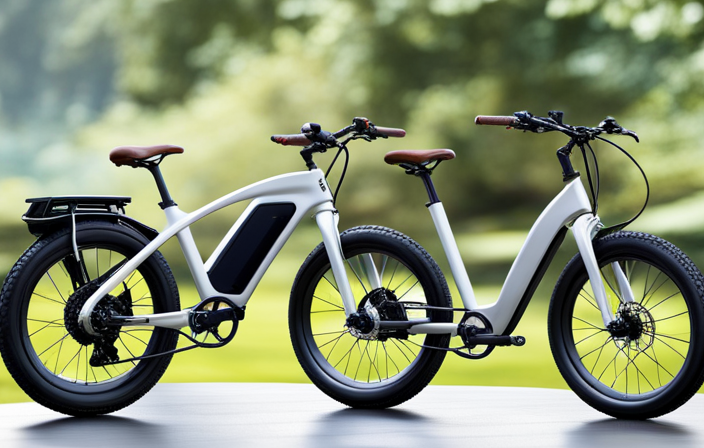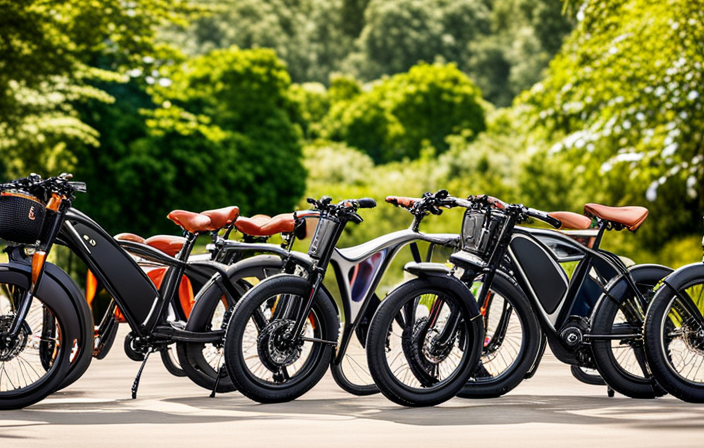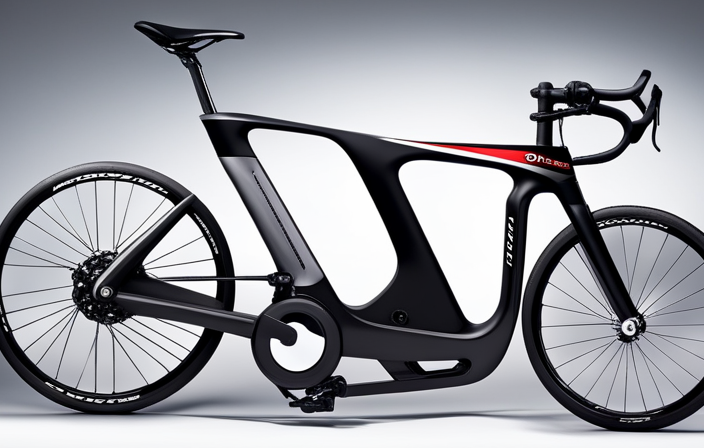I have always enjoyed the adrenaline rush of exploring trails on my electric bike, but nothing dampens the excitement more than a low battery. That is why I have mastered the art of charging while on the move.
In this article, I’ll share my top tips for keeping your electric bike juiced up while out on the trail. From understanding your battery’s range to exploring bike-friendly campgrounds with charging facilities, I’ve got you covered.
So, let’s dive in and ensure you never get stranded with a dead battery again.
Key Takeaways
- Familiarize yourself with your electric bike’s battery range.
- Research charging infrastructure along the trail and map out charging stops in advance.
- Consider alternative charging methods such as portable solar chargers, regenerative braking, and extra batteries or power banks.
- Optimize energy efficiency by using energy-efficient riding techniques, optimizing bike settings, and considering a battery upgrade.
Understand Your Battery’s Range and Capacity
Before heading out on the trail, make sure you understand your battery’s range and capacity. This knowledge is crucial for planning your ride and ensuring you have enough power to make it back to your starting point. Battery maintenance plays a significant role in maximizing battery life and ensuring optimal performance.
To begin, familiarize yourself with the range of your electric bike’s battery. Different models have different ranges, and it’s essential to know how far you can go on a single charge. This information will help you determine the length and difficulty of your ride, preventing any unexpected battery drain along the way.
Understanding your battery’s capacity is equally important. Battery capacity is measured in watt-hours (Wh) and indicates the amount of energy the battery can hold. By knowing the capacity, you can estimate how long your battery will last before needing a recharge. It’s essential to remember that using power-hungry features like high-speed modes or excessive throttle usage can drain your battery faster.
Maximizing battery life involves adopting good charging practices. Avoid overcharging your battery, as this can reduce its overall capacity over time. It’s best to charge your battery regularly and avoid letting it fully discharge before recharging. A good rule of thumb is to charge your battery when it reaches around 20-30% capacity.
By understanding your battery’s range and capacity and implementing proper battery maintenance practices, you can ensure your electric bike’s battery lasts longer and provides reliable power on the trail.
Now that you have a good grasp of your battery’s capabilities, let’s move on to planning your route with charging stations in mind.
Plan Your Route with Charging Stations in Mind
During your ride, make sure to plan your route with charging stations in mind. It’s crucial to have a clear understanding of where you can recharge your electric bike’s battery along the trail. Start by researching the charging infrastructure in the area you’ll be riding through. Look for charging stations specifically designed for electric bikes or e-bikes. These stations usually offer fast charging options that can replenish your battery in a relatively short amount of time.
Additionally, consider finding alternative power sources such as cafes, restaurants, or public buildings that may have outlets available for use. Mapping out these charging stops in advance will ensure that you never find yourself stranded with a drained battery.
Now, let’s talk about investing in a portable solar charger. This handy device is a game-changer for riders who enjoy longer trips or off-the-grid adventures. A portable solar charger allows you to harness the power of the sun to recharge your electric bike’s battery. It’s lightweight, compact, and easy to carry, making it a convenient solution for charging your bike during breaks or overnight.
With a portable solar charger, you’ll have the freedom to explore remote areas without worrying about finding charging stations. It’s a sustainable and reliable option that ensures you can keep pedaling even in the most remote locations.
Invest in a Portable Solar Charger
To make the most of your off-the-grid adventures, consider investing in a portable solar charger for your e-bike. These chargers utilize portable solar panels to harness the power of the sun and convert it into energy that can charge your e-bike’s battery. Portable solar panels have come a long way in terms of efficiency, meaning they can generate more power from a smaller surface area. This makes them perfect for outdoor enthusiasts who need a reliable and compact charging solution.
When choosing a portable solar charger, consider the wattage and size of the panels. Higher wattage panels will charge your e-bike faster, but they may also be bulkier and heavier. Look for panels that strike a balance between power output and portability. Additionally, consider the battery capacity of your e-bike. A larger battery will require more charging time and a higher wattage solar panel.
Once you have your portable solar charger, it’s important to position it correctly to maximize solar panel efficiency. Ensure that the panels are facing the sun and are not obstructed by any objects. Angle them towards the sun for optimal exposure. Some portable solar chargers even come with built-in stands or mounting options to make this process easier.
By investing in a portable solar charger, you can keep your e-bike charged and ready to go, even while off the grid. This allows you to explore remote areas without worrying about running out of battery power.
In the next section, I will discuss another technique to charge your e-bike while on the trail: utilizing regenerative braking.
Utilize Regenerative Braking
Another way you can extend the battery life of your e-bike is by utilizing regenerative braking. This feature converts the kinetic energy generated when you brake into electrical energy that can be stored in the battery. Regenerative braking is an efficient way to recharge your e-bike’s battery while on the trail. When you apply the brakes, the motor acts as a generator, converting the energy of motion into electricity. This electricity is then stored in the battery for later use.
Regenerative braking has its limitations, though. It is most effective when you are braking from higher speeds, as this generates more kinetic energy to be converted into electrical energy. At lower speeds, the amount of energy generated is significantly lower. Additionally, regenerative braking efficiency is affected by factors such as the weight of the rider and the terrain. Heavier riders and hilly terrains may not generate as much energy as lighter riders and flat terrains.
Nevertheless, utilizing regenerative braking can still make a significant difference in extending your e-bike’s battery life. It allows you to recharge your battery while on the go, reducing the need for frequent stops to charge. By maximizing the use of regenerative braking, you can conserve your battery power and enjoy longer rides on the trail.
To further extend your e-bike’s battery life, you can also consider bringing extra batteries or power banks. These portable charging options provide additional power when your battery runs low, allowing you to continue riding without worrying about running out of battery.
Bring Extra Batteries or Power Banks
Bringing extra batteries or power banks can provide additional power for your e-bike when the battery runs low. While most e-bikes come with a built-in battery, it’s always a good idea to have a backup plan. Power bank alternatives are a great option for those seeking lightweight battery options.
When it comes to power bank alternatives, there are a few things to consider. First, look for power banks that are specifically designed for e-bikes. These power banks are equipped with the necessary voltage and current output to charge your e-bike battery efficiently. Additionally, opt for power banks that are lightweight and compact, making them easy to carry during your rides.
There are also lightweight battery options available that can be easily attached to your e-bike frame. These batteries are designed to be compact and can provide additional power when needed. Some even have the option for quick charging, allowing you to get back on the trail in no time.
Take Advantage of Rest Stops and Public Charging Stations
As I mentioned earlier, bringing extra batteries or power banks is a great way to ensure you have enough power for your electric bike while on the trail. However, relying solely on these portable power sources may not always be feasible, especially on longer rides. That’s when it’s time to take advantage of rest stops and public charging stations along your route.
Rest stops and public charging stations can be a godsend for electric bike riders. Not only do they provide the opportunity to recharge your bike’s battery, but they also offer various amenities that can make your journey more comfortable. Here are a couple of reasons why you should consider utilizing these charging options:
-
Convenience: Rest stops and public charging stations are strategically placed along popular cycling routes, making them easily accessible for riders. You won’t have to go out of your way to find a charging point, allowing you to rest and recharge simultaneously.
-
Charging Etiquette: When using rest stops or public charging stations, it’s important to be mindful of others who may also need to charge their electric bikes. Follow these charging etiquette tips to ensure a smooth experience for everyone:
-
Only use the charging station for the necessary amount of time.
-
If there are limited charging ports, prioritize those who have low battery levels.
-
Avoid leaving your bike unattended while charging to prevent any mishaps or theft.
Use a Portable Generator
To keep your electric bike powered up in remote areas, you can use a portable generator. This is a great option for those who enjoy long rides or bikepacking trips where access to electrical outlets is limited. Portable generators are versatile and can provide you with a reliable source of power to charge your electric bike’s battery while on the go.
However, if a portable generator is not a feasible option for you, there are alternative ways to charge your electric bike while on the trail. One option is to use solar panels. These panels can be attached to your bike or backpack, harnessing the power of the sun to charge your bike’s battery. Another option is to utilize power banks specifically designed for charging electric bikes. These compact and portable devices can store a significant amount of power and allow you to charge your bike’s battery multiple times.
Consider a dynamo hub as another option for charging your electric bike on the go. A dynamo hub is a small generator built into the front wheel of your bike. As you ride, the hub generates electricity which can be used to charge your bike’s battery or power other electronic devices. This is a convenient and efficient solution, as it eliminates the need to carry additional equipment or rely on external power sources.
Consider a Dynamo Hub
Consider using a dynamo hub to power up your e-bike while you’re on the go. A dynamo hub is a built-in generator that produces electricity as you pedal. It’s a convenient and eco-friendly way to charge your electric bike while you’re out on the trail.
One of the benefits of using a dynamo hub is that it eliminates the need for external charging methods. Instead of relying on portable generators or solar panels, you can simply pedal and generate electricity to charge your bike’s battery. This not only saves you the hassle of carrying extra equipment, but it also reduces your reliance on fossil fuels and helps minimize your carbon footprint.
To better understand the benefits of a dynamo hub, consider the following table:
| Dynamo Hub Benefits |
|---|
| 1. Eco-friendly charging method |
| 2. No need for external power sources |
| 3. Convenient and efficient |
| 4. Reduces reliance on fossil fuels |
| 5. Adds versatility to your e-bike |
By utilizing a dynamo hub, you can charge your e-bike on the go and enjoy a continuous power supply without the need for alternative charging methods. This allows you to focus on your trail ride and explore further without worrying about running out of battery power.
Transitioning into the subsequent section about learning how to efficiently use power assist modes, it’s important to understand the different power levels and how they can enhance your riding experience.
Learn How to Efficiently Use Power Assist Modes
While a dynamo hub is a great way to generate power while riding, it’s important to also optimize the usage of power assist modes to ensure efficient power management and battery optimization. Power assist modes come in different levels, typically ranging from eco mode to turbo mode, each offering varying levels of assistance. Understanding how to make the most of these modes can significantly extend your battery life and allow you to charge your electric bike while on the trail.
When riding on flat terrain or going downhill, using lower power assist modes like eco or tour can help conserve battery power. These modes provide enough assistance to make pedaling easier without draining the battery quickly. On the other hand, when facing uphill or strong headwinds, switching to higher power assist modes like sport or turbo can provide the extra boost you need while still being mindful of battery usage.
It’s important to find the right balance between power assist modes and your own pedaling effort. By utilizing the different modes strategically and efficiently, you can maximize your battery life and make the most of your electric bike.
And speaking of maximizing battery life, another important aspect to consider is taking breaks to charge your bike.
Take Breaks to Charge Your Bike
When you’re out riding, make sure to take breaks and recharge your battery whenever you can. Properly managing your electric bike’s battery life is crucial to ensuring a smooth and enjoyable ride. To maximize your battery’s lifespan and reduce the risk of running out of power on the trail, it’s important to implement effective bike charging strategies.
One of the most effective strategies is to take advantage of opportunities to charge your bike during breaks. Many electric bikes have removable batteries, so you can easily bring an extra battery with you. This way, when you stop for a break, you can swap out the depleted battery for a fully charged one. This not only extends your ride time, but also gives your primary battery a chance to cool down and rest, which can help optimize its lifespan.
Additionally, you can look for opportunities to charge at cafes or restaurants along your route. Many establishments now offer charging stations specifically for electric bikes. By taking advantage of these charging stations during your breaks, you can top up your battery and ensure that you have enough power to complete your ride.
Transition: In addition to taking breaks to charge your bike, another effective strategy is to look for opportunities to charge at cafes or restaurants.
Look for Opportunities to Charge at Cafes or Restaurants
Another way to extend your electric bike’s battery life is by taking advantage of cafes or restaurants that offer charging stations along your route. This not only allows you to charge your bike while enjoying a meal or a cup of coffee, but it also gives you the opportunity to explore different charging options and practice charging station etiquette.
When using a charging station at a cafe or restaurant, it is important to be mindful of others who may also need to use the station. Remember to unplug your bike once it is fully charged to free up the space for others. Additionally, it is courteous to ask the staff for permission before using their charging station, as some establishments may have specific policies or restrictions.
In addition to traditional charging stations, you can also explore unconventional ways to charge your electric bike. Some cafes or restaurants may offer alternative charging options, such as solar-powered charging stations or portable charging devices. These options can be particularly useful if you are in a remote area where traditional charging stations may not be available.
Carry a Charging Adapter for Different Outlet Types
To ensure you can charge your e-bike at any cafe or restaurant along your route, it’s important to carry a charging adapter for different outlet types. This small and portable device allows you to connect your bike’s charger to various power sources, ensuring that you can easily recharge your battery no matter where you are.
Here are four types of charging adapters that you should consider adding to your biking essentials:
-
Standard Outlet Adapter: This adapter allows you to plug your bike’s charger into any standard electrical outlet commonly found in homes or businesses.
-
USB Adapter: With this adapter, you can charge your e-bike using the USB ports available in many cafes or restaurants, providing a convenient and alternative power source.
-
Solar Panel Charger: A solar panel charger harnesses the power of the sun to recharge your bike’s battery. It’s a great option for outdoor enthusiasts who want to rely on renewable energy sources while on the trail.
-
Car Adapter: This adapter plugs into your car’s cigarette lighter or power outlet, allowing you to charge your e-bike while on the go.
By carrying these charging adapters, you’ll have the flexibility to charge your e-bike at various locations and utilize alternative power sources.
Now, let’s explore bike-friendly campgrounds with charging facilities.
Explore Bike-Friendly Campgrounds with Charging Facilities
Make sure you research and choose bike-friendly campgrounds that offer charging facilities for your e-bike. When planning a trip with your electric bike, it’s crucial to find accommodations that cater to your specific needs. Many campgrounds now recognize the growing popularity of electric bikes and have started providing bike-friendly amenities, including charging facilities. These campgrounds understand the importance of offering alternative charging options to ensure that e-bike riders can enjoy their adventures without worrying about running out of battery power.
Bike-friendly campgrounds with charging facilities typically offer designated areas where you can safely charge your electric bike. These areas are equipped with charging stations or outlets specifically designed for e-bikes. Some campgrounds even provide charging cables compatible with various e-bike models, so you don’t have to worry about bringing your own.
In addition to charging facilities, bike-friendly campgrounds often offer other amenities tailored to e-bike riders. These may include secure bike storage, repair stations, and maps of nearby trails suitable for electric biking. By choosing a campground that caters to e-bike enthusiasts, you can ensure a seamless and enjoyable experience throughout your trip.
To connect with the electric bike community for charging tips and advice, you can join online forums, social media groups, or attend e-bike events. These platforms provide a wealth of knowledge and opportunities to learn from experienced riders. By engaging with the electric bike community, you can gain valuable insights into the best charging practices and discover new charging options that may not be widely known.
Transition: By exploring bike-friendly campgrounds with charging facilities and connecting with the electric bike community, you can ensure that your e-bike is always charged and ready for your next trail adventure.
Connect with the Electric Bike Community for Charging Tips and Advice
Engage with the electric bike community to gain valuable insights and discover new tips and advice for keeping your e-bike battery powered during your adventures. Being part of a community of like-minded individuals who share your passion for electric biking can provide you with a wealth of knowledge and resources.
One of the best ways to connect with the electric bike community is through community events and meetups. These events are often organized by local electric bike clubs or organizations and provide an opportunity to meet fellow riders, share experiences, and learn from each other.
In addition to community events, there are also online forums and social media groups dedicated to electric biking. These platforms allow you to connect with electric bike enthusiasts from all over the world and exchange information about charging solutions and connectivity options. From portable chargers to solar panels, the electric bike community can offer valuable insights into the best ways to keep your battery powered while on the trail.
By engaging with the electric bike community, you can stay up-to-date with the latest advancements in connectivity solutions and learn about new products and technologies that can enhance your e-bike charging experience. So, make sure to connect with the electric bike community and tap into their collective knowledge to ensure your battery stays powered on your adventures.
Transitioning into the subsequent section about ‘practice energy-saving techniques to extend battery life,’ it’s important to not only rely on external charging solutions but also adopt energy-saving habits that can help you make the most of your battery power.
Practice Energy-Saving Techniques to Extend Battery Life
By adopting energy-saving habits, you can maximize the life of your e-bike battery. Proper battery maintenance is essential for ensuring optimal performance and longevity. Here are some energy-saving techniques and battery maintenance tips to help you get the most out of your electric bike:
| Energy Saving Techniques | Battery Maintenance |
|---|---|
| Use pedal assist wisely | Regularly clean and inspect the battery |
| Maintain a steady pace | Store the battery at the right temperature |
| Avoid unnecessary stops | Avoid overcharging the battery |
| Choose efficient routes | Keep the battery terminals clean |
| Monitor your battery level | Avoid extreme temperatures |
Using pedal assist wisely can significantly extend your battery life. Instead of relying solely on the motor, try to pedal along with the assistance. Maintaining a steady pace also helps conserve energy, so avoid sudden accelerations or decelerations whenever possible. Plan your routes efficiently to avoid unnecessary stops and choose paths with less incline to reduce strain on the battery.
In addition to energy-saving techniques, proper battery maintenance is crucial. Regularly clean and inspect the battery for any signs of damage or wear. Store the battery in a cool, dry place, away from direct sunlight or extreme temperatures. Avoid overcharging the battery by monitoring its level and disconnecting it from the charger once fully charged. Lastly, keep the battery terminals clean and free from dirt or corrosion to ensure optimal conductivity.
Frequently Asked Questions
Can I charge my electric bike while riding on the trail?
Yes, you can charge your electric bike while riding on the trail. There are various charging options available for electric bikes, including portable chargers.
These chargers are lightweight and compact, making them easy to carry with you while riding. Simply connect the portable charger to your bike’s battery and it will start charging while you ride.
This allows you to extend your riding time and explore even further on your electric bike.
How long does it typically take to fully charge an electric bike battery?
The charging time of an electric bike battery can vary depending on several factors. Factors such as the battery capacity, charger output, and the level of depletion can all affect the charging time.
On average, it takes around 3 to 6 hours to fully charge an electric bike battery. However, it is important to consider that some high-capacity batteries may take longer.
Additionally, charging times may also be influenced by the type of charger being used.
Are there any safety precautions I should take when charging my electric bike on the trail?
When it comes to charging my electric bike on the trail, safety is my top priority. I always make sure to take necessary precautions to avoid any mishaps.
One key aspect is using the right charging equipment. I have a reliable portable charger that is specifically designed for outdoor use. It has built-in safety features like overcharge protection and temperature control.
Additionally, I always keep an eye on the charging process and never leave my bike unattended while it’s charging.
Can I use a regular power bank to charge my electric bike battery?
Yes, you can use a regular power bank to charge your electric bike battery on the trail. Power banks are designed to provide portable power for various devices, including smartphones and tablets. While they may not have the same capacity as a dedicated electric bike charger, they can still provide a sufficient amount of power to charge your battery partially or fully.
It’s a convenient and alternative way to charge your electric bike battery while on the trail, especially if you don’t have access to a traditional power source.
Are there any specific guidelines or regulations for charging electric bikes at public charging stations?
When it comes to charging electric bikes at public stations, there are some specific guidelines and regulations to keep in mind. These guidelines may differ from charging at home.
Public charging stations offer numerous benefits, such as faster charging times and access to specialized equipment. Additionally, they often have safety measures in place to protect both the bike and the charger.
Following the guidelines ensures a smooth and efficient charging experience.
Conclusion
In conclusion, charging your electric bike while on the trail requires careful planning and preparation. By understanding your battery’s range and capacity, planning your route with charging stations in mind, and investing in portable solar chargers, you can ensure a seamless charging experience.
Additionally, utilizing regenerative braking, carrying extra batteries or power banks, and bringing a charging adapter for different outlet types will provide you with backup options.
Finally, exploring bike-friendly campgrounds with charging facilities and connecting with the electric bike community for tips and advice will further enhance your charging capabilities.
Remember, practicing energy-saving techniques will help extend your battery life and keep you on the trail for longer.
















